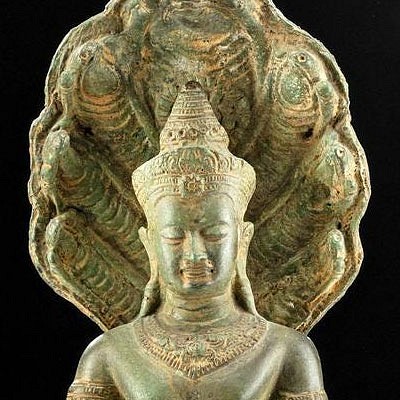19th C. Chinese Qing Porcelain Bowl, ex-General Chen Qi
Lot 1
About Seller
Artemis Fine Arts
686 S Taylor Ave, Ste 106
Louisville, CO 80027
United States
Selling antiquities, ancient and ethnographic art online since 1993, Artemis Gallery specializes in Classical Antiquities (Egyptian, Greek, Roman, Near Eastern), Asian, Pre-Columbian, African / Tribal / Oceanographic art. Our extensive inventory includes pottery, stone, metal, wood, glass and textil...Read more
Categories
Estimate:
$7,000 - $10,500
Absentee vs Live bid
Two ways to bid:
- Leave a max absentee bid and the platform will bid on your behalf up to your maximum bid during the live auction.
- Bid live during the auction and your bids will be submitted real-time to the auctioneer.
Bid Increments
| Price | Bid Increment |
|---|---|
| $0 | $25 |
| $300 | $50 |
| $1,000 | $100 |
| $2,000 | $250 |
| $5,000 | $500 |
| $10,000 | $1,000 |
| $20,000 | $2,500 |
| $50,000 | $5,000 |
| $100,000 | $10,000 |
| $200,000 | $20,000 |
About Auction
By Artemis Fine Arts
Aug 10, 2021
Set Reminder
2021-08-10 12:00:00
2021-08-10 12:00:00
America/New_York
Bidsquare
Bidsquare : Museum-Deaccession | Asian & Pre-Columbian
https://www.bidsquare.com/auctions/artemis-gallery/museum-deaccession-asian-pre-columbian-7316
An interesting mix of de-accessioned Asian and Pre-Columbian Art from The Ashland University Museum in Ashland, OH, originally donated between 1994 to 1998. All lots from the Museum have been noted, as such. Artemis Fine Arts info@artemisgallery.com
An interesting mix of de-accessioned Asian and Pre-Columbian Art from The Ashland University Museum in Ashland, OH, originally donated between 1994 to 1998. All lots from the Museum have been noted, as such. Artemis Fine Arts info@artemisgallery.com
- Lot Description
East Asia, China, Qing Dynasty, ca. 19th to early 20th century CE. A well-preserved porcelain bowl with a scalloped rim and lovely painted motifs. The vessel rests on a ring base with a blue stamp seal containing the character for QianLong Reign Period of Great Qing (1735-1796). The exterior sides are painted with a scrolling vine with a lotus, a chrysanthemum, and a peony flower on a white ground. The wide rim and basin interior are decorated with gilt, a pale green ground, and a centralized flower medallion surrounded by gilt characters, as well as four additional characters that symbolize happiness from all directions. The interior walls also contain stylized bats, another symbol of good luck and happiness. This bowl is covered with auspicious symbols and has a lovely array of hues, creating a spectacular composition! Size: 11.25" Diameter x 3.375" H (28.6 cm x 8.6 cm)
This piece comes from the important collection of General Chen Qi (1912-2000) who styled himself as "Cangquan" and "Yuquanshanren" - an artist, calligrapher, businessman, and art collector. Born in Fujian on March 8, 1912 to a merchant family, Chen Qi was introduced to traditional culture and literacy by his grandfather beginning in 1916. He was well-versed in enlightenment readings such as Three Character Classic, Thousand Poems, Book of Filial Piety, and Confucian classics, etc. In addition, he studied Tang Kai (one of the traditional Chinese calligraphy scripts that originated during the Tang Dynasty).
Chen Qi went to Japan in 1932 and enrolled in the reputable Imperial Japanese Army Academy, a famous military school founded in 1868. The Imperial Japanese Army Academy was dedicated to Militaristic Spiritual Education and trained an impressive number of senior generals. In 1935, the National Revolutionary Army appointed Chen Qi to teach in Republic of China Military Academy (also called Huangpu Military Academy). In time he was named Deputy Director of Training and earned the rank of Major General. Despite working in the military during a turbulent period, Chen Qi was still inspired by Confucianism and his traditional cultural education. He continued to study painting and collected arts and antiques from various Chinese Dynasties. After arriving at Taiwan, Chen Qi was appointed military official of the Indonesian embassy in 1955, where he developed a close relationships with Pu Xinyu, Zhang Daqian, Huang Junbi, Xu Fuguan, Hu Shi, and Yu Youren, etc.
Chen Qi left his position in Indonesia in 1965 and during the 1980s would travel frequently to mainland China. He made numerous generous contributions to nonprofit programs and organizations in his homeland, fostering efforts to build schools, improve water conservation, and develop the newspaper industry. During his golden years, he embraced his artistic interests and studied calligraphy.
This piece has been searched against the Art Loss Register database and has been cleared. The Art Loss Register maintains the world’s largest database of stolen art, collectibles, and antiques.
Provenance: private Morrison, Colorado, USA collection; ex-General Chen Qi (1912-2000) collection, acquired by 1990s
All items legal to buy/sell under U.S. Statute covering cultural patrimony Code 2600, CHAPTER 14, and are guaranteed to be as described or your money back.
A Certificate of Authenticity will accompany all winning bids.
PLEASE NOTE: Due to recent increases of shipments being seized by Australian & German customs (even for items with pre-UNESCO provenance), we will no longer ship most antiquities and ancient Chinese art to Australia & Germany. For categories of items that are acceptable to ship to Australia or Germany, please contact us directly or work with your local customs brokerage firm.
Display stands not described as included/custom in the item description are for photography purposes only and will not be included with the item upon shipping.
#163372Age commensurate and minor surface wear with scratches and pitting. Old inventory label on base. Overall excellent condition with vibrant colors!Condition
- Shipping Info
-
All shipping is handled in-house for your convenience. Your invoice from Artemis Gallery will include shipping calculation instructions. If in doubt, please inquire BEFORE bidding for estimated shipping costs for individual items.
-
- Buyer's Premium



 EUR
EUR CAD
CAD AUD
AUD GBP
GBP MXN
MXN HKD
HKD CNY
CNY MYR
MYR SEK
SEK SGD
SGD CHF
CHF THB
THB
















